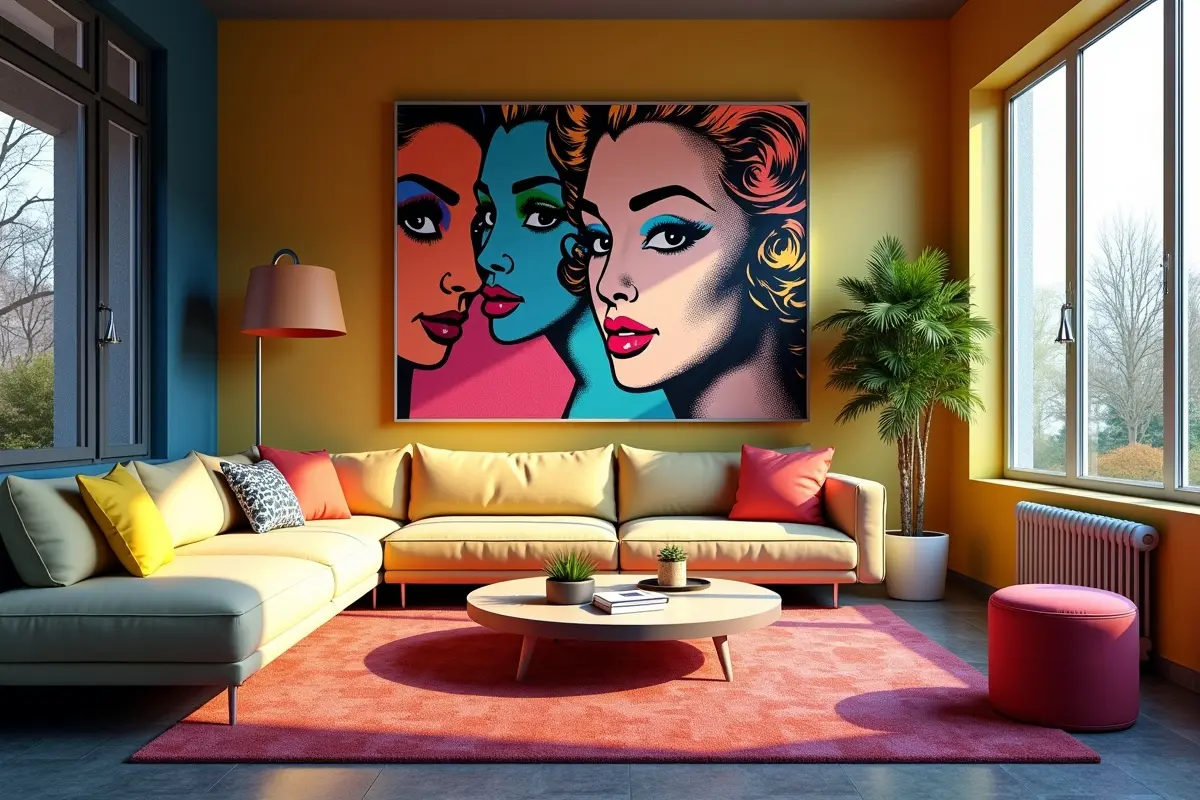Pop art has this amazing ability to completely transform a room’s personality. What started as an artistic rebellion in the 1950s has become one of the most accessible and impactful ways to add character to modern homes. But here’s the thing – choosing the right pop art for your space isn’t just about picking something colorful and calling it a day.
The beauty of pop art lies in its bold, unapologetic nature. It draws from popular culture, advertising, and everyday objects, turning them into something that demands attention. Think Andy Warhol’s soup cans or Roy Lichtenstein’s comic book-inspired pieces.
Understanding Your Space and Style
Before diving into specific pieces, take a honest look at your current setup. Pop art works best when it has room to breathe and make a statement. A small, cluttered room might feel overwhelmed by a large, vibrant piece, while a spacious area with minimal furniture could handle something more dramatic.
Consider your existing color palette too. Pop art doesn’t have to match everything perfectly – in fact, it often works better when it provides a striking contrast. If your room is mostly neutral, a bold pop art piece can serve as the perfect focal point. On the flip side, if you already have strong colors in your furniture or walls, you might want something that complements rather than competes.
The style of your home matters as well. Modern and contemporary spaces naturally embrace pop art’s clean lines and bold graphics. But don’t assume it won’t work in traditional settings. Sometimes the most interesting interiors come from unexpected combinations. A classic Victorian home with a well-chosen pop art piece can create a fascinating dialogue between old and new.
Size and Placement Strategies
Getting the scale right is crucial. A common mistake is choosing pieces that are too small for the space. Pop art works best when it can command attention, so don’t be afraid to go bigger than you initially think. For a standard living room wall, consider pieces that are at least 24 by 36 inches. Larger spaces can handle even more substantial works.
Wall placement follows some basic rules, but there’s room for creativity. The center of your artwork should generally sit at eye level, roughly 57 to 60 inches from the floor. But in a living room where people spend most of their time seated, you might want to hang pieces slightly lower so they’re properly positioned for the viewing angle from your couch.
Many collectors discover that investing in quality pop art canvas prints offers the perfect balance of visual impact and affordability.
Think about creating visual relationships between multiple pieces too. A series of smaller pop art works can create just as much impact as one large piece, especially when they share common elements like color schemes or themes. The key is maintaining enough space between pieces so each can be appreciated individually while contributing to the overall composition.
Color Coordination Without Compromise
Pop art’s relationship with color is what makes it both exciting and potentially challenging. The good news is that you don’t need to perfectly match your existing decor. Pop art often works best when it introduces new colors to a space, creating energy and visual interest.
Start by identifying the dominant colors in your room. Then look for pop art that either complements these colors or provides a strategic contrast. A room dominated by cool blues and grays might benefit from a pop art piece with warm reds or oranges. Conversely, a warm-toned space could be energized by something with cool blues or purples.
Don’t overlook the power of black and white pop art either. These pieces can provide sophistication while still maintaining the graphic boldness that defines the style.
Subject Matter That Speaks to You
Pop art covers an enormous range of subjects, from iconic celebrities and consumer products to abstract interpretations of popular culture. The subject matter you choose should reflect your personality and interests, but also consider how it will fit into your daily life.
Celebrity portraits are classic pop art territory, but think about whether you want to live with that particular face every day. Food and product imagery can be fun and approachable – think of those famous Coca-Cola or Campbell’s soup references. Abstract pop art takes the style’s bold graphics and applies them to non-representational forms, which can be perfect for people who want the energy without specific imagery.
Consider the room’s function too. A vibrant, energetic piece might be perfect for a living room or home office but too stimulating for a bedroom. Conversely, a bedroom might be the perfect place for a more intimate or romantic pop art piece that would get lost in a larger social space.
Quality and Longevity Considerations
Not all pop art reproductions are created equal. Look for pieces printed on quality materials that will maintain their vibrancy over time. Canvas prints generally offer better longevity than paper prints, and they provide that authentic artistic texture that enhances the overall presentation.
Pay attention to the printing process as well. Giclee printing, which uses archival inks, offers superior color accuracy and fade resistance compared to standard digital printing. While it might cost more upfront, quality printing ensures your pop art investment will look good for years to come.
Framing decisions can significantly impact both the appearance and preservation of your pop art. While many canvas pieces look great without frames, adding one can provide extra protection and help integrate the piece with your existing decor. Consider the frame as part of the overall composition – a sleek, modern frame might enhance a minimalist pop art piece, while a more substantial frame could help a bold piece hold its own in a traditional setting.
Making Your Final Selection
The most important factor in choosing pop art is your personal connection to the piece. You’ll be living with this artwork daily, so it should genuinely appeal to you rather than just fitting a decorating trend. Take time to consider how different pieces make you feel and whether that emotional response aligns with how you want to experience your space.
Consider starting with one strong piece rather than trying to decorate an entire room with pop art at once. A single well-chosen work can transform a space and give you time to understand how pop art functions in your particular environment. You can always add more pieces later as you develop your eye and confidence with the style.
Pop art’s enduring appeal lies in its ability to bring energy, personality, and visual interest to any space. By considering your room’s specific characteristics, your personal style preferences, and the practical aspects of size and placement, you can choose pieces that will enhance your living space for years to come. The key is finding that perfect balance between bold artistic statement and harmonious integration with your existing decor.





Leave a Reply
You must be logged in to post a comment.